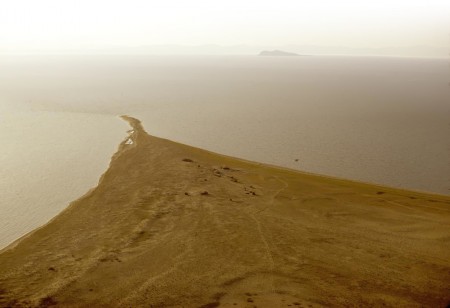Lake Turkana (formerly Lake Rudolf) is situated in northern Kenya and extends into southern Ethiopia. Since the early part of the twentieth century, it has been known as an important source of terrestrial vertebrate fossils dating from the last 30 million years, but it was not until the 1960s that detailed studies were carried out both in the Ethiopian and Kenyan sediments. Between 1967 and 1976, the International Omo Expedition, which initially included French, American and Kenyan contingents, explored the southern Ethiopian Turkana Basin deposits. Richard Leakey coordinated the Kenyan expedition on behalf of his father, Louis Leakey.

The original base camp and research facility was built on the Koobi Fora spit, which extends out into the lake from its eastern shore.
While Richard Leakey was flying back to the Omo River one day in 1967, his plane was diverted to the east side of Lake Turkana by storms. Richard noticed extensive exposures below him, of what appeared to be sedimentary rocks. This area had previously been mapped as volcanic basalts but the possible presence of sedimentary rocks led Richard to wonder if fossils might be found there. The following year he led the first expedition to prospect the Kenyan exposures on the lake’s north-eastern shores. Thus began a long and fruitful period of exploration and discovery under the auspices of the Koobi Fora Research Project.
Fieldwork has been conducted in the Kenyan portion of the Turkana Basin each year since 1968, with multidisciplinary teams from all over the world unearthing some of the most stunning finds in the field of human origins. Research on both shores has provided an exceptional depth of understanding of the past geological and paleoenvironmental history of the area in which so many dramatic steps in the human evolutionary story are documented.
The hominid fossil collection, which currently comprises several hundred specimens, including several exceptionally complete skulls and an almost complete skeleton, has put Kenya firmly on the map as a key contributor to human evolution studies. Much of the fossil evidence for human evolution between 7 and 1 million years, since the African ape and human lineages split, has been unearthed in the Turkana Basin. The hominins recovered demonstrate that our history includes at least four genera and seven species of early bipedal apes that are all implicated in the development of the only living bipedal ape, Homo sapiens.
With the establishment of TBI, the work of the last forty years is brought into the twenty-first century. TBI’s state-of-the-art research facilities will promote further discoveries, improving our understanding of prehistory and natural science.
